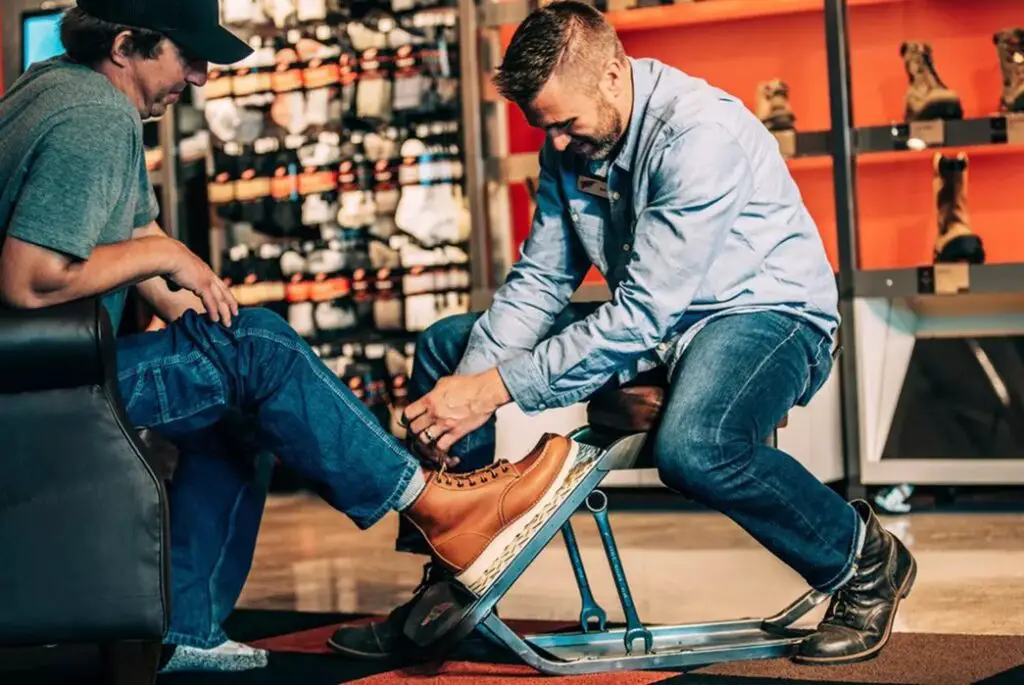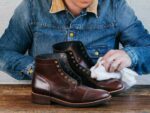Should New Leather Boots Feel Tight? Been restlessly googling to find an answer to this question after trying out your new pair of leather boots? Hey! Be cool.
It’s quite natural for your brand new leather boots to feel a little tight. So, your next doubt will probably be whether leather boots stretch? Let’s check it out.
Will Leather Boots Stretch?
Yes! Leather boots will stretch about a quarter of your boot size. You all know that leather is a natural material. Leather being a hide is pliable; will stretch and change its size under pressure.
However, the type, treatment, and age of your leather tell you how much it will stretch. And the process is going to test your patience because this will take some time.
Also please note that this stretching won’t help if you have purchased the wrong size.

How to Break In Your New Leather Boot?
Now, let us find out how to break in a leather boot; what to do, and what not to do to make your leather boot from an uncomfortable to a perfect fit.
1.) Wear Your Boots around Your House
Leather boots stretch over time on their use. When you wear the boots for a considerable period, out of pressure, the boots will eventually conform to the shape of your feet.
So, before wearing it for your real purpose, make it a habit to wear your new leather boots in your house for a 30 minute or one-hour stretch daily. This will gradually make your boot a perfect fit.
2.) Wear Socks
Wear thick cotton socks with the boot. It will speed up the break-in process by giving extra pressure to the boot to stretch.
3.) Dab Moisturizer on Your Boots
Applying moisturizer on a leather boot will soften it and get the break-in easier. Moreover, it will help in increasing the longevity of your leather boots.
4.) Apply Leather-Stretching Spray
Try out any of the leather-stretching sprays available in the market on your boots. It will help in quicker softening and stretching of the leather as you wear it.
Don’ts!
Never try to submerge your leather boot in water to soften it. It will dry your boots and develop cracks and tears.
Heating your leather boot might soften it but it will have adverse effects on your boot. So never try to heat it. Don’t blow-dry or steam your leather boots or put them in the oven, It will dry the leather.
How Is A Perfect-Fit Boot?
Not too loose nor too tight, that’s how your boot should fit in. A perfect fit should align to the instep and ball of your foot and fit snugly to the bottom of your foot.
There should be enough space for one finger to fit comfortably between the back of your ankle and the boot. Your boot is too loose if there is space for two fingers. You should also be able to wiggle your toes freely.
A tight boot will make you suffer from discomfort, blisters, calluses, foot pain, ingrown toenails, and other long-term complications. Air circulation will be meager if a tight shoe.
If your boots are bigger for your feet, the boots’ breakpoint and arch support won’t get aligned with your feet. Your heel will move up and down and it will cause heel pain, overpronation, corns, etc. So, it’s paramount to buy the perfect size for a healthy and happy walk.
How to Pick the Right Boot?
To purchase the right boot, you need to know your feet well. To know your feet, you need to take the measurement of your feet and examine the features of your feet.
How to Measure Your Feet?
Stand on a piece of paper and trace your foot.
Measure the length from your longest toe to the very end of your foot.
Measure the width of the widest part of your foot.
Repeat the procedures with the other foot since both feet might vary in size.
Now you have the size of your foot. But remember, your foot size is not your boot size. Your boot size should be 0.25 or 0.5 cm longer than your foot size.
Talking about the width, boots are typically available in 6 widths from B to EEE. But, manufacturers usually sell regular (D) and E (wide) sizes.
Make sure which category your foot belongs to before purchasing a boot. You can even get a boot customized to the measurements and features of your foot.
There are a few more factors of prime importance to examine before you bag a leather boot, that is; flex point, width, heel, and arch of the boot.
1.) The flex point of your foot is the point where the toes and ball of the foot join. Your boot must flex at the spot where your foot does.
So, before purchasing a boot, check whether your foot’s flex point is on point with the boot’s flex point. It will cause discomfort and blisters in the other case.
2.) A terrible fit in the width can damage your feet and ankles. Check if the widest part of the boot lays in line with the corresponding part of your foot and purchase the boot according to the width of your foot.
3.) It’s not a problem if your heel slips a little from the boot. Gradual break-in will shape your boot to your foot and reduce the slip.
But if the heel isn’t snugging to your foot even after break-in, your foot will rub against the boot and will cause inflammation and develop blisters. You can use a heel snug in this case to remedy it.
4.) You need to know the kind of arch support your feet need. If you have a flat foot, you need a boot that provides arch support.
If your arch is well-maintained, arch support is not a matter. If your boot doesn’t provide arch support, you can use ultra-thin orthotic soles.
A Few More Tips!
1.) It’s best to go shopping for a leather boot at night because your feet will be more exposed and expanded rather than in the daytime. It’s the best time to try out a boot.
2.) Trial new boots with the socks you use to wear with boots. While wearing socks, the boot shouldn’t feel tight but snug.
3.) If you are purchasing a leather boot online, check for its return policy before you empty your cart.
4.) Check the size chart before purchasing since measurements vary with different brands.
5.) Don’t buy a boot expecting that it will stretch over time. Never compromise with the size of your boot.
How to Prevent Shoe Bites/ Blisters?
1.) Choose the right boot. As simple as that! Ill-fitting boots are the main reason for shoe bites.
2.) Avoid going outside with your new leather boots before it breaks in.
3.) Wear thick socks to induce less friction.
4.) Stick a band-aid or surgical tape on your foot in areas prone to shoe bites.
5.) Apply a layer of petroleum jelly or moisturizer to your feet to reduce friction.
6.) Insert shoe pads/insoles to prevent abrasion on your heels and tongue pads to prevent toe injuries.
To conclude, you need not throw your brand new pair of boots into the trash if it feels a little tight. It will break in over time.
But never buy a wrong-sized boot assuming it will stretch after two or three uses. You will get disappointed. A leather boot is quite an expensive investment, so buy the right fit and have a happy and stylish walk.







